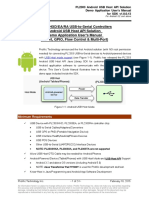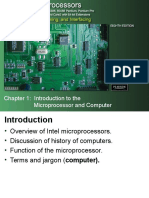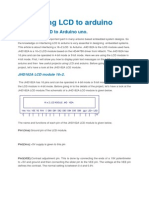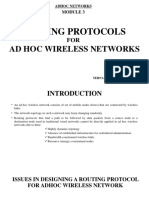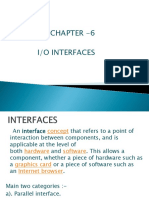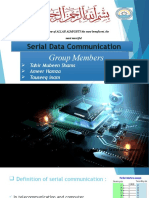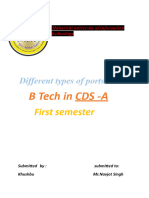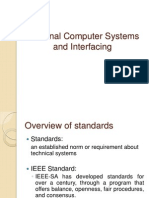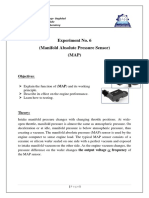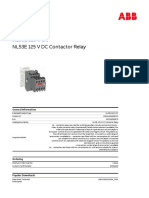CHAPTER Serial and Parallel Communication
Chapter Objectives
Explain serial communication
Standards, ports, resources etc.
Show a few examples of serial communication connections used in practice Describe the features of parallel communication
Standards, use etc.
�Chapter Modules
Serial communication Newer serial communication technologies Serial communication connections Parallel communication
�Module
Serial Communication
�Chapter Objectives
Explain serial communication
Standards, ports, resources etc.
Show a few examples of serial communication connections and ports used in practice
�Definition of Serial Communication
Travels in series
A B Bit by bit transmission of information in series
�Serial Communication Implementation
Popular implementation found in older and some newer computers is known as the RS-232 serial connection found in microcomputers Newer type of serial connections
Universal Serial Bus (USB) IEEE 1394 serial connection that is also known as the FireWire
�Other Serial Communication Technologies
eSATA Fiber channel
�RS-232C Serial Standard
The most popular standard Conforming serial ports are found in the following
Micro Minis and mainframes
Sometimes these ports are also known as the asynchronous ports or asnch ports in short It is also possible to conduct synchronous transmission through these ports as well
�Purpose of the Serial Ports
Serial Interface
Parallel Digital Data
Expansion Bus
In Out Serial Digital Data
�Standard Serial Port on a Computer (DB 9)
�Serial Port Identification
Source: Black Box
�Male and Female Connectors
Pins
Holes
Typical serial port
Source Black Box
Typical parallel port
�Differentiating Between Serial and Parallel Ports
Parallel Female Port Serial Male Port
�Serial Cable
DB9 Connector
DB25 Connector
Source Black Box
�End of Module
�Module
Resources for Serial Ports
�Support for Serial Ports
Both hardware and software support are required for the functioning of serial ports A microcomputer is supplied with two standard serial ports
Additional ports can be installed
�Operating System Support
Earlier operating systems
Supported four serial ports
Todays operating systems
Support a larger number of serial ports
For most practical purposes, four serial ports are considered sufficient in a microcomputer
Only two, namely com1 and com2,
�Port Properties
Com 1 Com2 Com3 Com4
IRQ I/O Address Base Memory Address Direct Memory Address (DMA) Channel
�Assignment of Values
The assignment of the respective values for each port must be unique An IRQ, I/O address or DMA conflict can lead to a disruption in the execution of an application
This is no more a problem with newer OS and hardware
�IRQ and Address Assignment
PORT IRQ ADDRESS -----------------------------------------------------------1 2 3 4 4 3 3F8-3FF 2F8-2FF These values should not normally be changed.
�End of Module
�Module
Faster RS-232 Serial Ports and Summary
�Older and Newer Serial Ports
Older serial ports operated at a slower speed The newer serial ports operate at a faster speed The newer serial ports are equipped with a new processor The hardware in question is known as the UART processor
�Enhanced Serial Ports
Universal Asynchronous Receiver Transmitter (UART
UART 16550/ 16650
Com. Port
The newer processor is required for communication at speeds of 115,200 bps
�ISDN Line Requirement
In theory, the maximum speed over a single ISDN line is approximately 128K bps If necessary, enhanced serial ports can be installed by installing a board containing the enhanced ports
�UART-based Ports
�In Summary
Two standard serial ports are present on a microcomputer Resources
IRQ, I/O Address and DMA
Port settings
Communication speed, length of the data bits etc.
Later versions of the UART chip are required to support high speed communication through the serial
�End of Module
�Module
Newer Serial Communication Technologies: Universal Serial Bus (USB)
�Universal Serial Bus
Being introduced as a high-speed replacement for the traditional RS-232 port USB has higher bandwidth
1.5 Mbps, 12 Mbps and 480 Mbps Faster than the RS-232 port that operates in the region of 115+ K bps
Devices can be daisy-chained
�Daisy Chaining of USB Devices
USB Connection Device 3
Computer
USB Port In
Device 1 Device 2
Out
�Connecting USB Devices Using a Hub
USB Connection Device 3
Computer
USB Port In
Hub
Device 2
Out
�Sample USB Devices
Keyboards Monitors Digital Cameras Digital Vide Recorders etc.
�USB Standards
USB 1.1 USB 2.0 USB On-The-Go (OTG)
A newer standard being designed for portable and small devices
�U3 Standard
�USB Connectors
Type A
Upstream connectors From the system Downstream connectors To the device
Type B Mini A Mini B
mini-A and mini-B and mini-AB
Smaller connector for PDAs, mobile phones and digital cameras Small for factor connectors for USB OTG
�Support for the Deployment of USB in Microcomputers
There are two requirements for USB implementation One is the presence of USB hubs to support USB ports on the microcomputer The other is the support required from the operating system to operate the USB Most motherboards now have built-in support for USB Not all versions of the Windows OS support for USB
�Operating System Support for USB
The newer operating systems such as Windows XP or the later versions of some of the older operating systems support USB
Windows 98 Windows 95 OSR2
In accordance with USB standards, these operating systems support hot plug-and-play for USB devices
�Hot Plug-and-Play
The ability to connect a device to the computer while a computer is in operation As the device is connected, the OS would:
Recognize the device Configure the device
There is no manual intervention in the above process
�Advantages of USB Over the RS-232 Port
Higher speed Ability to daisy chain different devices Support for hot plug-and-play
�End of Module
�Module
IEEE 1394 FireWire Connection
�IEEE 1394 Standard (FireWire)
In some ways, it competes with USB Bandwidth is 400M bps or 50M Bps In theory therefore, it can replace older SCSI and IDE used for connecting hard disks FireWires impact is most likely to be felt in multimedia applications involving audio and video Some basic networking can be done through the Firewire ports as well
�Data Transmission
100 Mbps, 200 Mbps and 400 Mbps Newer ports are being developed to support 800 Mbps and 1600 Mbps Data is transmitted in packets and it is available to all the devices on the bus
�Networking with Firewire
1394 supports peer-to-peer networks based on point-to-point connections Computers can be networked in a peer-to-peer architecture using the Firewire port
�Type of Transmission
Asynchronous (bulk) transfer guarantees correct transmission; suitable for control data and where error-free transmission takes precedence over speed. Isochronous transfer - guarantees bandwidth (ideal for transmitting time critical data, e.g. video, audio) Courtesy: www.thesycon.de
� The maximum distance between nodes is 4.5 m (revisions to the standard will support distances of 100 m between nodes Up to 27 devices can be connected to each node. Courtesy: www.thesycon.de
� Hot-swapping allows users to attach and detach devices while the network is running; the network is reconfigured automatically. Each bus supports up to 64 nodes and the specification supports up to 1024 buses. A 1394 bus appears as a flat space in memory, with each node occupying a 48 bit address range. Integrated power supply - devices receive power through the bus. Courtesy: www.thesycon.de
�End of Module
�Module
Fiber Channel
�End of Module
�Module
Serial Communication Connections
�Unix Computer Connection
Multiple serial ports
Multi-user Micro (Unix) RS-232C Connection ASCII Terminal Microcomputer ASCII Terminal
�Multiple Port Support
Interface Card
Multiple Ports
�Popular Unix Configuration
Central Unix server TCP/IP
Microcomputers as terminals
�Remote Access Server
LAN
Server with Multi-serial Ports RS-232C Connection Modem Modem Modem
Dial-in access
�LapLink Connection
Laptop/ Notebook/ Computer RS-232C Serial Lap-link Connection
Desktop Computer
Note: Lap Link serial cable is specially wired to make the connection
�X.25 Standard
Used in WAN connections X.25 is used in the U.S. Its equivalent X.21 is used in Europe Today, the above older technologies are being replaced with newer digital technologies
ATM Frame Relay etc.
�End of Module
�Module
Parallel Communication
�Definition of Parallel Communication
Transmission of information over multiple links between two points
Multiple electronic links
�Parallel Transmission
Multiple links
�IEEE 488 Parallel Standard
Established by IEEE Used extensively in parallel Communication Examples:
Computer to printer connection Lap Link connection
Does not play as important a role as the serial standard
Hardly any parallel long distance links in practice
�Parallel Port and Serial Ports in a Microcomputer
DB25F DB9M DB25M
Parallel LPT1: Serial Com1: Serial Com2:
�Parallel Port Resources
Resources must also be assigned to the parallel port as well
IRQ and I/O address range
Sample values assigned for LPT1
IRQ 7 I/O address range 378 - 37f These values should not be changed in general
�Summary
A microcomputer is equipped with one standard parallel port Additional parallel ports can be installed Used extensively for connecting a printer
Used for connecting other devices as well
Needs to be assigned resources Identified by the DB25 female
�Parallel Port Resource Assignment Demonstration
�End of Module
�Module
Newer and Faster Parallel Port Standards
�Popular Introductions
Standard Parallel Port (SPP) Enhanced Parallel Port (EPP) Extended Capability Port (ECP)
�EPP and ECP
Enhanced Parallel Port (EPP)
Introduced in 1991 to increase the parallel port communication speed to 500K Bps
Extended Capability Port (ECP)
Introduced further refinement to the EPP For better performance under a multitasking environment
�Support for EPP and ECP
Must be built into the hardware namely into the motherboard Activated at the system level by enabling the support for EPP and ECP in the system BIOS For example, the System BIOS can be accessed during boot-up by pressing the delete key immediately after switching on the power to the computer
�Other Features Supported
Wake-up signal sent to the printer Consider the case of a newer laser printer that is attached to a microcomputer through an ECP port
Printer must also be connected to the microcomputer using a cable conforming to the IEEE specification
�Wake Up Feature
No printing activity for a predetermined period of time
Printer enters into a sleep mode Printer does not consume power
When a print job is ready for printing
Computer sends a signal to wake up the printer The printing then proceeds thereafter
�Salient Features of EPP and ECP
EPP was introduced to increase the speed of the parallel port ECP was introduced to add further enhancements to EPP
Improve the performance under multitasking
�End of Module
�Module
ECP Computer Entry
�ECP Entry Check
�End of Module
�END OF MODULE END OF CHAPTER


